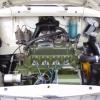Hi All
I have just completed repairs to the grill panel on my Mk1 Cooper. Up to now, the last coat added was halfords primer. the surfaces are now very good, with almost all blemishes gone.
Bfore adding top coat (I will use Cellulose), do I Have to rub down the primer? If so, for what reason, and does it have to be wet-or dry?
The tiny few blemishes I can leave for the top coat application as this can be rubbed back and cut to make perfectly smooth after several coats.
Thanks

Rub down before painting?
Started by
mk=john
, Dec 24 2006 06:22 PM
5 replies to this topic
#1

Posted 24 December 2006 - 06:22 PM
#2

Posted 24 December 2006 - 06:37 PM
I'm no expert but remember celly does not fill holes or blemishes so in an ideal world you need the primer to be the same finish as you want your end result.
If you expect to flat the celly to get your finish you may go through to the primer.
If you expect to flat the celly to get your finish you may go through to the primer.
#3

Posted 24 December 2006 - 07:19 PM
u need to leeve the primer till its completely dry then wet flat the primer down so its really smooth
then put your layers of top coat on leave it 10 15 mins between coats last coat just dust it on to cover evenly
when its dry tack rag it off then put your layers of laquers on leeve 10 15 mins between coats
then to get a good finish wet flat the laquer down when its dry next day probably then use some cutting polish to buff it back up
then put your layers of top coat on leave it 10 15 mins between coats last coat just dust it on to cover evenly
when its dry tack rag it off then put your layers of laquers on leeve 10 15 mins between coats
then to get a good finish wet flat the laquer down when its dry next day probably then use some cutting polish to buff it back up
#4

Posted 25 December 2006 - 09:27 AM
Having watched a man do a celly paintjob on a moggy, he did a few heavy coats of primer, colour sanded flat then covered (and i do mean covered) the whole car in stopper. This meant ALOT more work but every imperfection was gone, all little pin holes filled and a lovely surface to paint on.
He then did the celly, from what i can remember about 7 costs of celly (you can get away with 2 with 2pack) and serious amount of rubbing down before it went out to customer.
Celly is hard work compaired to 2k
He then did the celly, from what i can remember about 7 costs of celly (you can get away with 2 with 2pack) and serious amount of rubbing down before it went out to customer.
Celly is hard work compaired to 2k
#5

Posted 26 December 2006 - 02:48 PM
Hi
You mentioned stopper? What is that, and is it something halfords might sell?
I have dont a last coat of primer...surfaces 99% perfect at this stage.
Thanks
You mentioned stopper? What is that, and is it something halfords might sell?
I have dont a last coat of primer...surfaces 99% perfect at this stage.
Thanks
#6

Posted 27 December 2006 - 11:58 AM
if i remember correctly, 'Stopper' is a type of 'High build primer' that fills tiny holes and also creates a chemical proof barrier, this stops the chances of any sort of reaction between the topcoat and primer.
Wet sanding is Wet to help cut down scratches to the paint/primer, the water lubricates the paper and surface allowing i to cut but not scratch. you can buy purpose produced lubricants for this to dilute and sand with.
Wet sanding is Wet to help cut down scratches to the paint/primer, the water lubricates the paper and surface allowing i to cut but not scratch. you can buy purpose produced lubricants for this to dilute and sand with.
1 user(s) are reading this topic
0 members, 1 guests, 0 anonymous users















